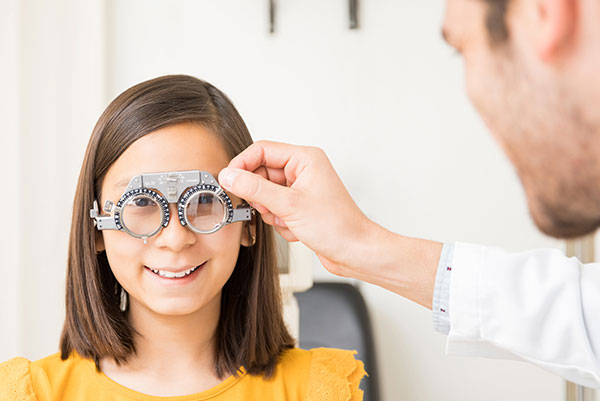It is the first and only lens that can be customized after cataract surgery. Click here to learn more
Click here to learn more.
Vision problems in children affect their ability to learn, read and play, making it essential to address them as soon as possible. Catching sight issues early can be complicated by children being unable to communicate effectively and any fears they may have around going to the doctor. Geneva Eye Clinic’s pediatric ophthalmologist and techs specialize in all aspects of pediatric eye care. Our medical team is committed to treating your child with extra attention and compassion, from managing complex medical and surgical problems to routine vision care.


Eye exams for children may take longer than adult exams. After the technician performs the first part of the exam, the doctor may need to see the child before inserting any eye drops. This allows the doctor to check the eye muscles and take any measurements as required.
Next, the child’s eyes will be dilated with eye drops. Your child’s eyes will remain dilated for 6 to 8 hours, maybe longer, and they will be sensitive to bright light and blurry for near vision. We have disposable sunglasses available to make them more comfortable.
After dilation takes effect (approximately 30 minutes), your child will be brought back to see the doctor again, who will perform the rest of the exam. An exam usually entails using a microscope called a slit lamp to view the front structures of the eyes and bright lights to view the retina and optic nerves. This may be uncomfortable for a child, but it will not harm their eyes. The doctor will discuss the exam findings and any treatment plans if needed with you.
The pediatric eye exam is approximately a two-hour process. Please anticipate your child’s visit to require this length of time.
Strabismus refers to misaligned eyes. If the eyes turn inward (crossed), it is called esotropia. If the eyes turn outward (wall-eyed), it is called exotropia. Sometimes one eye is higher than the other, called hypertropia (for the higher eye) or hypotropia (for the lower eye). Strabismus can be subtle or obvious, intermittent (occurring occasionally), or constant. It can affect one eye only or shift between the eyes.
Strabismus usually begins in infancy or childhood. Some toddlers have accommodative esotropia. Their eyes cross because they need glasses for farsightedness. But most cases of strabismus do not have a well-understood cause. It seems to develop because the eye muscles are uncoordinated and do not move the eyes together. Acquired strabismus can occasionally occur because of a problem in the brain, an injury to the eye socket, or thyroid eye disease.
When young children develop strabismus, they typically have mild symptoms. They may hold their heads to one side if they can use their eyes together in that position. Or, they may close or cover one eye when it deviates, especially at first. On the other hand, adults have more symptoms when they develop strabismus. They have double vision (see a second image) and may lose depth perception. At all ages, strabismus is disturbing. Studies show that school children with significant strabismus have self-image problems.
Strabismus is often treated by surgically adjusting the tension on the eye muscles. The goal of surgery is to get the eyes close enough to be perfectly straight that it is hard to see any residual deviation. Surgery usually improves the conditions though the results are rarely perfect. Results are generally better in young children. Surgery can be done with local anesthesia in some adults but requires general anesthesia in children, usually outpatient. In some cases, prisms and Botox injections of the eye muscles are alternatives to surgery. Eye exercises rarely help.
If left untreated, strabismus in children can lead to amblyopia or a “lazy eye.” Children learn to suppress double vision so effectively that the deviating eye gradually loses sight. It may be necessary to patch the good eye and wear glasses before treating the strabismus. Amblyopia does not occur when alternate eyes deviate, and adults do not develop amblyopia.
Amblyopia treatment corrects when one eye sees a blurred image which the brain shuts off or suppresses. When caught early, amblyopia treatment, often called lazy eye treatment, can successfully restore functional sight to the amblyopic eye.
Cataracts sometimes appear in children at birth in one or both eyes. They look like a white or gray spot in the pupil. Cataracts may be inherited, develop due to an infection, a disease acquired before birth, or result of an injury. In most cases, there is no specific cause found.
If a severe cataract is not removed quickly, the child may lose their vision permanently because of amblyopia (lazy eye). The better eye may also need to be patched. Mild cataracts may not need treatment.
The focusing power of the original lens, removed during cataract surgery, must be replaced to restore vision. Intraocular lenses (IOLs), permanent plastic lenses placed inside the eye, are implanted in older children like adults. In infants, IOLs are controversial because the eyes grow and change their prescriptions during the first few years of life. Many surgeons prefer contact lenses or even glasses for younger children.
Regardless of the type of correction, children need follow-up exams to avoid possible complications, including glaucoma, scar tissue forming in the pupil, and amblyopia. Often, children will need eye muscle surgery because the eye turns or crosses.
Despite these problems, cataracts are the single most treatable cause of childhood blindness. After surgery, most children can see the blackboard in school (20/60-20/100). While some do not do as well, many children will see almost normally with appropriate correction.